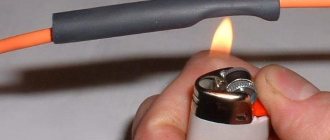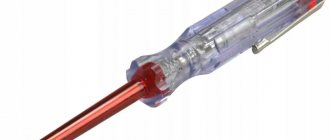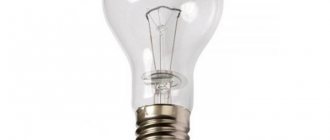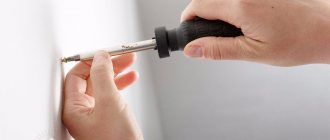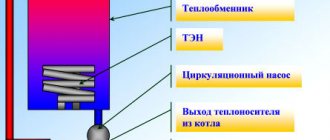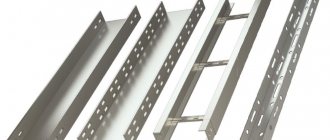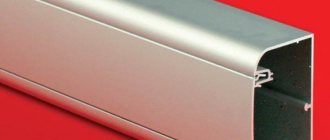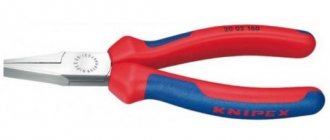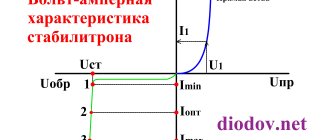Every home should have a screwdriver. Of course, there is no need to purchase all varieties, but it is very easy to understand which ones you need for your home. Such a tool is necessary for replacing an outlet or switch, repairing an apartment and household appliances. Of course, you can buy a screwdriver, but for minor repairs it is absolutely useless. You can get by with the simplest and most inexpensive alternative. In this article we will look at existing types of screwdrivers and their purpose, markings, as well as photo examples.
Design features
Flat and shaped screwdrivers have one thing in common - the design of the tool. It consists of a round metal rod with a tip and a handle.
Kernel
Indicator screwdriver - how to use it correctly
The steel axis is the part that transmits the force of the hand from the handle to the tip of the screwdriver. The material for this is especially strong steel. Products differ in the length and thickness of the rods, the cross-section of which can be round or multifaceted.
Important! The rod can have different lengths, diameters and cross-sectional shapes. Standard length is 100-200 mm. The shaft is usually coated with nickel or chrome to protect against corrosion. The rods are also made of stainless steel.
Lever
This part is mainly made of plastic. The quality of the material affects the durability of the handle. Modern handles of high-quality products have non-slip rubberized inserts, a finger rest, and a large area for hand grip and palm rest.
Also at the bottom of the handle a transverse through hole is made to enhance torque. A rod is inserted through it to obtain additional force.
Professional OS on the handles have gel inserts that fit tightly to the palm, which ensures maximum transfer of force to the sting.
Sting
The effectiveness of the sting largely depends on the quality and strength of the tip material. Tips made from C-2 tool steel are considered high-quality and reliable tips. Particularly durable tips are made from molybdenum-vanadium alloy.
Flat head screwdriver
Sonic screwdriver for checking current
Crimping pliers
Among the many similar tools, a special slotted screwdriver stands out, which consists of the same materials as a simple one, but also includes a device that signals with sound and a light sign the presence of electric current in the wired network, and also shows its rating and load.
Screwdriver with indicator
This device is often used to check the presence of current in the wiring panel and determine its power. It is not recommended to use a sonic screwdriver as a tool for unscrewing or tightening screws, since its tip is very thin, and if excessive force is applied, the metal can be deformed, and the mechanism inside the handle can turn and fail completely. This device can only be used for its intended purpose, to determine the current strength and load on the network.
If the screwdriver is equipped with a speaker, then when the screw rod touches the circuit breaker, a certain sound is heard, which signals the presence of power in the network. Often such screwdrivers are equipped with diode lamps as an additional signal. There are two types of diodes on the handle, red and green, each of which performs a specific function and task.
It is worth noting that there is no Phillips screwdriver with such a device, since to safely touch live wires you need a very thin tip, and there is no point in producing Phillips screwdrivers with a built-in indicator.
Markings and dimensions of a slotted screwdriver
Pulse soldering iron gun
Branded products have markings placed on the longitudinal surface or on the end of the handle. It meets the requirements of the international classification of hand tools. If you need a tool for household needs: unscrew and tighten screws, then you need to understand what the marking of the tool means: SL , PH , PZ :
- SL – regular flat spline;
- PH – Phillips screwdriver;
- PZ – the same with the presence of thin ray lines.
The marking can be in the form of a circle, inside which the pepper section of the tip is depicted. So, for example, flat screwdrivers are indicated by a stripe, Phillips screwdrivers - by a cross in a circle. All indicator instruments have a flat tip. Accordingly, shaped screwdrivers in the marking are displayed by the type of tip profile.
Hardware with various slot shapes
Around the circle, the manufacturer indicates the dimensions of the slot and the length of the rod. Marking with a circle with a stripe inside it. The dimensions of a slotted screwdriver are marked on the rim: 1.2 x 6.5 x 125 mm means that this is a flat screwdriver, designed to work with screws whose slots have dimensions of 1.2 x 6.5 mm, the length of the rod is 125 mm.
A marking with a cross containing the inscription PH 1 x 80 mm means a Phillips screwdriver of the following dimensions: 1 – fastener head diameter number, shaft length – 80 mm.
Cross School
To ensure that the work is not a burden and does not create unnecessary problems, the correct choice of tools plays an important role. If we talk about screwdrivers, then more often than others I have to work with Phillips screwdrivers. I will tell you in this article how to choose it so as not to “rip off” the screw and the screwdriver itself. Few people know that Phillips screwdrivers come in two main types, each of which must work with its own screws or screws: PH (Phillips) and PZ (Pozidriv). And the difference, of course, is not only in the name. The PH marking was patented by Phillips. By and large, this is the usual and most common Phillips screwdriver. It is done by anyone and everyone, using the simplest or most complex alloys and coatings, which, according to numerous manufacturers, should improve the fixation of the screwdriver in the slot of the screw or screw and reduce the force of the screwdriver coming out of them. There are persistent rumors that Phillips has released several improved versions of its screwdriver (Phillips II and Phillips SQUARE-DRIVE), but I have not yet seen them. The PZ marking was patented by GKN from Great Britain in 1962. Just as in the first case, it designates the type of cross-shaped slot of fasteners and screwdrivers for them. In essence, Pozidriv is an improved modification of Phillips, although it is used much less frequently. The difference is that in PZ screwdrivers, thin ray-shaped notches run from the inner corners of the slot, and the working edges are parallel on their sides (in PH they become thinner towards the tip of the screwdriver). Here, a more stable grip in the screwdriver-screw connection is expected, which should reduce wear and the likelihood of the screwdriver and screw breaking off. But the problem is that many screwdriver users simply do not notice the difference, working with the tool that is at hand or simply mixing it up - due to the external similarity, this is easy to do. If this happens, then a screwdriver that does not match the screw slot will not fit tightly, which will disrupt the contact of their working surfaces, sharply increase mechanical stress and the likelihood of failure. This will lead not only to an increase in operating time and a decrease in its quality, but also to an early failure of both the screwdriver itself and the screws.
Left: PH bit tip, right: PZ bit tip
If you have a choice, you can distinguish between PH and PZ screwdrivers or bits by designation or additional notches (see photo above). Phillips screwdrivers or bits always indicate their type and size. For example, PH1x80 or PZ2x100. In the first case, we are dealing with a Phillips screwdriver size 1 and a working part length of 80 mm. The second contains a Pozidriv slotted screwdriver, size 2, with a working part length of 100 mm. Well, screws or other fasteners with cross-head slots are distinguished by the notches on their heads. They are not present in PH, while in PZ they are easy to spot:
Left: screw head with PH slot, right - with PZ slot
Just above I mentioned the sizes of screwdrivers. I will return to them to close this question as well. Of course, for a tight grip, the size of the screwdriver and the screw slot must match. In this case, the size of the screwdriver determines the diameter of the fastener thread. For Phillips screwdrivers, there are five sizes in total: 0, 1, 2, 3, 4. Perhaps the most popular of them are No. 1 and 2. Below is a table from which you can quite accurately determine the slot number by the diameter of the external thread of the fastener:
| Screwdriver PH or PZ, no. | Thread diameter |
| 0 | up to 2 mm |
| 1 | 2.1-3.0 mm |
| 2 | 3.1-5.0 mm |
| 3 | 5.1-7.0 mm |
| 4 | from 7.1 mm |
That's all.
Use the right screwdriver! In the end, this is not only a high level of assembly, but also your time saved. Which, by the way, can be spent with much greater benefit than searching for new fasteners in stores... Earlier, a reference article was published on the Sharpening Blog, which examined in detail the shapes of heads and fastening screws and the types of their splines. In my opinion, given the focus of the material published above, this information will be of interest to the reader - read the article “SCREW: HEADS FORMS AND TYPES OF SLIDES”... ZAT (Dnepr, Ukraine) https://www.zat24.com/ Send by emailWrite blog about it Post on Twitter Post on Facebook
Types of screwdrivers
Electrician's kit - what tools are included?
What types of screwdrivers there are can be represented by a fairly large list. You should consider popular and highly specialized types of screwdrivers.
Dielectric
To work with electrical equipment, use a dielectric screwdriver. It does not allow current up to 1000 V to pass through it. The entire instrument is covered with special plastic up to the tip. Electricians use such OSHs to work in electrical cabinets and switchboards.
Tool with dielectric coating
Reversible
The sonic screwdriver is equipped with ratcheting mechanisms. When the tip rotates, the ratchet makes a ratcheting sound. The tool can only rotate in one direction. To turn on the reverse mode, move the lever. Thanks to this device, the master tightens or unscrews the screw without removing the tip from the fastener slots. Reversible tools are otherwise called minus screwdrivers.
Reversible screwdriver
Hexagon
Hexagon-shaped screwdriver slots allow you to apply maximum force to the tool without fear of cutting off the edges of the tip or slots. Fasteners are used in places where the requirements for the strength of the connection of parts are especially high.
Star-shaped
Star-shaped splines are especially popular in the countries of the American continent. In European products for various purposes, star screws are quite common in electronic devices. Their use is subject to the same requirements as for hexagonal tips.
Square
A square-shaped slot is not found in everyday life. Hardware with square openings in the heads is used for mounting parts of special equipment, including in the defense industry.
U-shaped OS
Tools with double tips are called spanners. They are used in elevator facilities. The complex configuration of the tips is aimed at preventing incidents of vandalism in elevator cabins.
Fork
Similar to U-shaped screwdrivers, except that instead of two blades, they have a triple tip. This is a purely professional tool. Screws with such slots are not found in everyday life.
Triangular
Triangular screwdrivers are professional tools. Triangle screwdrivers are compatible with slotted screws that have a similar configuration. Triangular screwdrivers are used for opening and installing panels where access to cabinets and panels with electrical or other equipment is limited.
For One-way slot
The name One-way translated from English means “one way path”. Unscrewing hardware with such a head is only possible with a special tool. Any use of other types of tips results in cutting off the splines. The fastener resists unauthorized entry into various devices.
Bristol
The shape of the spline resembles a six-pointed gear. You can unscrew such hardware only with a Bristol tip. Otherwise, the slot is destroyed and the screw has to be drilled out. Hardware can be found in radio electronics service centers. They are used to protect against vandal penetration into devices.
For Torg-Set slot
The tip is made for a slot in the form of a cross with an offset center. Hardware with such splines is practically not found in Russia.
For muna Torx slot
Screwdrivers for this type of slot have a tip in the form of a six-pointed star. They are necessary in workshops where mobile phones and various gadgets are repaired.
For star spline
The star tip is designed for screws with six-pointed star slots. The stars have sharper peaks. The scope of application is the same as that of the previous type of tool.
It is important to distinguish between the last two types, because using PZ for screws with PH slots can damage the self-tapping screw. As a result, the fasteners will have to be drilled out, and the screwdriver itself will fail.
Splines and tips
Note! If you have to deal with soured hardware, use an impact screwdriver. It is equipped with a thick metal cap at the end of the handle that can withstand hammer blows. When struck, the tip of the tool rotates with powerful force.
What should the core be?
The rods come in square, round or hexagonal shapes . They also have different lengths , but whatever screwdriver you need, the hardness of its shaft according to GOST should be 47-52 HRC. This is an indicator of hardness at which optimal strength is maintained with internal viscosity, which prevents the destruction of the rod when twisted with great force. If its strength is less than 47 units, then during operation it will simply bend, and if it is more than 52 units, then it may burst. Rods, like tips, are made from chrome vanadium steel . To prevent the formation of corrosion, the rod is coated with a galvanized protective layer.
How to choose a screwdriver
In order for the tool to serve for a long time and be comfortable to use, it is important to make the right choice of product. You need to understand what the OS will be used for.
Disassembling or installing parts of small devices will require the use of precision screwdrivers. They are used to disassemble or assemble watches, mobile phones, and the like.
For quick installation or disassembly of facing materials, furniture and other things, it is better to use an OS with a ratchet mechanism. A ratchet is a mechanism that allows the tool tip to rotate in only one direction. Such devices are equipped with a reversing device that changes the working stroke of the screwdriver clockwise and vice versa.
Products with a set of removable tips allow you to save on the purchase of tools with different tips. Stings can be purchased as needed. All handles and removable rod ends are compatible, regardless of their manufacturer. The set with interchangeable tips, shown in the bottom photo, allows you to quickly replace the tip with another tip.
Set of removable tips
Additional Information. When choosing a screwdriver, you need to pay attention to the quality of the plastic and the ergonomics of the handle. The quality of the metal from which the tip is made matters. The best material for this is chrome vanadium steel.
Flat screwdrivers with magnetic tip
Tip with magnet
These products are types of screwdrivers that are multifunctional; their tip is treated with a special magnetic paint that attracts metal objects or screws.
Important! Self-tapping screws and bolts only made of ordinary steel will be magnetized, since parts made of non-ferrous metals do not interact with the magnet.
All types of screwdrivers, both minus and figured, can be treated with this paint; in addition, the height of painting can be different. Such tools are easy to use, especially when operating in hard-to-reach places. Even if the fastener falls out of its seat, it can be retrieved simply by magnetizing it to the tip of a screwdriver.
A slotted screwdriver with bits can also be equipped with a magnet, but its difference from simple products lies not in the processing of the nozzles, but in the configuration of the rod. Since the pin for tips is hollow inside, most often it has the form of a tube with a hexagonal socket at the end, a magnet is placed inside it, which charges the entire metal rod and attracts the tip well. This arrangement is very advantageous, since, unlike paint, there is no impact on the magnet, so the part is not subject to wear.
Operation of screwdrivers
To operate the OS correctly, you must adhere to several rules:
- In the marking of products, according to GOST, the type of slot is encrypted (see the chapter “Marking” above). The screwdriver must be used in full accordance with the type and size of the slot;
- It is better to store the tool in a suspended state. In this case, the tips will be protected from accidental damage;
- Clean instruments are stored in dry indoor conditions that do not provoke metal corrosion.
The figure shows the most common shapes of screwdriver blades.
.
.
table 1 (blade shape configuration)
| form value | screwdriver blade shape | marking | simple name | note |
| A | Flat screwdriver | SL | minus | The designation SL5.5 denotes the width of the blade; SL 0.5x4 (0.5 is the thickness of the blade (slot), and 4 is the width |
| B | crosshead screwdriver | PH | plus | The contact area with the workpiece is larger than that of the SL type |
| C | Cross with additional guides | PZ | posidrive | Large torque |
| D | Alternative to the Crusade | Torx | star | Mainly used in electronic instrument making and automotive industries |
| E | Subsequent development of Torx | Torx with pin | star with pin | |
| F | Imbus keys | Hex | hexagon | For tightening hexagon screws. The number is assigned according to the distance in millimeters between the opposite corners of the hexagon. |
| G | Screwdriver type Hex | Hex typical | Square | Rarely consumed variety |
| H | Not a standard slot. | Tri-Wing | Shamrock | For products with non-standard slots |
| I | Cross asymmetrical | Torq | Double prong fork | Powerful pull. Used in high-tech industries. |
| K | Double-pin screwdriver | SP | Spanner | It is used in household appliances and elevator mechanisms. |
Self-production
You can make a screwdriver from any metal rod or nail. The rod is ground on a grinding machine on one side. Usually they make a tool with a tip for a straight slot.
Home craftsmen grind a head with an opening for replacement bits. It is welded to the end of the rod. The end of the rod on the other side is bent with a hook. You can use an old key for the blank. This is convenient because the tool can be carried on a key ring.
For a homemade cross OSH you will need a milling machine and a sharpener. The tip of the rod is milled, achieving a cruciform cross-section of the rod. Then the finished tip is ground into a cone shape.
An L-shaped fold is placed between the cut halves of a round block. Then both pieces are tightened with clamps. In another case, the bent end of the rod is placed in a mold and filled with epoxy resin. The handle is then ground down for comfortable hand grip.
The correct selection of slotted screwdrivers facilitates quick and efficient repair and installation of various devices and instruments with threaded connections. You can easily purchase suitable hand tools in the retail chain.
How to do it yourself?
Purchasing a ready-made set means a significant expense. Sometimes it includes extra tools that are not really needed. Or, on the contrary, such a thin device is required that it is not sold in ready-made kits. Very small screwdrivers are made from needles. Not only tailor's needles are suitable, but also those that come with household sewing machines. We need to get rid of the sharp edge, because it is not needed anyway. Next, the metal is annealed, systematically heating one of the ends to 900 degrees. Subsequent cooling should proceed slowly. The orange color of the edge indicates that heating has reached the required stage. If it is reddish, the heating should be increased, and if it reaches a light yellow or white tone, it should be reduced.
To heat the workpiece, you can use a regular gas stove burner
The needle must be cooled by carefully withdrawing it out. At this moment, the plastic qualities of the steel will increase, so it will be possible to immediately give the desired shape on a small anvil with blows of a miniature hammer.
Suitable anvils:
- the striking part of a larger hammer;
- steel pliers;
- pliers;
- another metal tool with a fairly large, level platform.
Forging can be improved by reheating the needle. This time, the speed of exit from the flame no longer plays a role. Having given the tip of the workpiece the required shape, it is finalized using a flat needle file. Sometimes they just polish it. Having finished processing, be sure to harden the screwdriver blade by heating its end to a dark cherry color and immediately after that dipping it into water.
A part hardened in this way is excessively fragile. You should definitely resort to another processing method - the so-called vacation. First of all, the workpiece is warmed so that it becomes either purple or light blue (iron acquires these tones in the range of 285-300 degrees). Since scale that appears on hardened metal will make it more difficult to accurately recognize colors, it must be removed. The release procedure ends with the needle cooling smoothly in the air.
In the next video you will find an unboxing and review of a set of watch screwdrivers.
